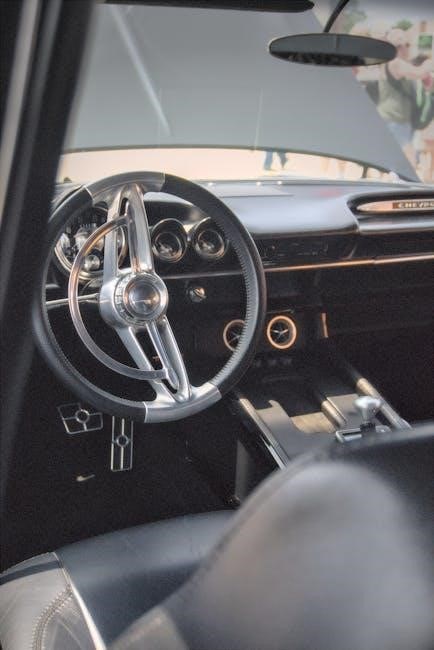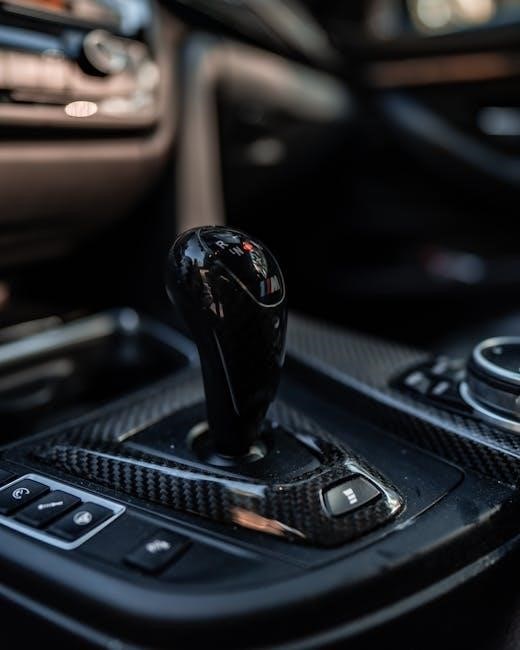The 5.7 Hemi engine‚ paired with a manual transmission‚ offers a powerful and efficient driving experience. Known for its robust performance‚ this combination enhances driver control and responsiveness.
1.1 Overview of the 5.7 Hemi Engine
The 5.7 Hemi engine‚ a 345 cubic-inch V8‚ is renowned for its power and efficiency. With a displacement of 5.7 liters‚ it delivers strong performance across various Mopar vehicles. Known for its hemispherical combustion chambers‚ the engine ensures efficient combustion and higher power output. While it offers impressive fuel efficiency for its size‚ some models have faced issues like oil consumption and lifter ticks. Despite these challenges‚ the 5.7 Hemi remains a popular choice for its balance of power and reliability‚ making it a staple in many Chrysler‚ Dodge‚ and RAM vehicles.
1.2 History of the Hemi Engine
The Hemi engine’s legacy dates back to 1951‚ when Chrysler first introduced its iconic hemispherical combustion chamber design. This innovation maximized power and efficiency‚ quickly making it a favorite in racing and performance vehicles. Over the years‚ the Hemi evolved‚ with the 5.7L version debuting in 2003‚ featuring modern advancements like variable valve timing and cylinder deactivation. Despite some challenges‚ the Hemi remains a symbol of power and heritage‚ continuing to power Chrysler‚ Dodge‚ and RAM vehicles with its signature performance and durability.
1.3 Benefits of a Manual Transmission
A manual transmission offers drivers unparalleled control and connection to the vehicle‚ especially when paired with the 5.7 Hemi engine. It provides better fuel efficiency in certain driving conditions and typically costs less than automatic transmissions. Manual transmissions also tend to be more durable and require less maintenance over time. For enthusiasts‚ the manual gearbox enhances the driving experience‚ offering a more engaging and precise way to harness the engine’s power. This makes it a popular choice for those seeking a more traditional‚ hands-on driving experience.

Engine Specifications
The 5.7 Hemi engine features a 345 cubic-inch displacement‚ 8 cylinders‚ and a pushrod-operated overhead valve design. It utilizes a multi-displacement system (MDS) for improved efficiency.
2.1 Displacement and Cylinder Configuration
The 5.7 Hemi engine features a displacement of 345 cubic inches‚ configured as a V8 with a 90-degree cylinder block. Its bore and stroke measurements are 3.92 inches and 3.58 inches‚ respectively‚ optimizing power delivery. The V8 design ensures balanced performance‚ while the hemispherical combustion chambers enhance airflow efficiency. This configuration supports smooth operation‚ combining strength and efficiency‚ making it ideal for both daily driving and high-performance applications. The engine’s design emphasizes durability and reliability‚ with lightweight materials like aluminum used in the cylinder blocks.
2.2 Horsepower and Torque Ratings
The 5.7 Hemi engine‚ when paired with a manual transmission‚ delivers impressive performance with 395 horsepower and 410 lb-ft of torque. This powerful V8 configuration ensures smooth acceleration and consistent power delivery. The manual transmission enhances driver control‚ allowing for precise gear shifts that maximize the engine’s capabilities. Whether towing heavy loads or driving aggressively‚ the 5.7 Hemi’s robust torque output provides confidence and reliability. Its combination of strength and efficiency makes it a standout choice for both work and recreation.
2.3 Fuel Efficiency
The 5.7 Hemi engine with a manual transmission offers moderate fuel efficiency‚ achieving an EPA-rated 14 MPG city and 22 MPG highway for rear-wheel-drive models. Four-wheel-drive configurations slightly reduce these figures to 13 MPG city and 20 MPG highway. The engine’s Variable Valve Timing (VVT) and Multi-Displacement System (MDS) contribute to improved fuel economy by deactivating cylinders under light loads. While not the most fuel-efficient option‚ the 5.7 Hemi balances performance and economy‚ making it a practical choice for drivers who need both power and reasonable mileage. Regular oil and filter changes further optimize efficiency.

Transmission Details
The 5.7 Hemi manual transmission typically features a Tremec TR-6060 six-speed gearbox‚ offering precise gear ratios that enhance acceleration and driving responsiveness. Regular clutch maintenance ensures optimal performance and durability.
3.1 Types of Manual Transmissions Compatible with 5.7 Hemi
The 5.7 Hemi engine is commonly paired with the Tremec TR-6060 six-speed manual transmission‚ known for its durability and smooth shifting. This gearbox is designed to handle the engine’s high torque output‚ making it ideal for both daily driving and performance applications. Some enthusiasts also opt for aftermarket transmissions like the Magnum T-56 or TR-3160‚ which offer enhanced strength for racing or heavily modified engines. These transmissions are compatible with the 5.7 Hemi’s power delivery‚ ensuring optimal performance and control.
3.2 Gear Ratios and Shift Quality
The 5.7 Hemi manual transmission typically features a six-speed setup with carefully calibrated gear ratios. Lower gears provide strong acceleration and towing capability‚ while higher gears enhance fuel efficiency at cruising speeds. The Tremec TR-6060 is renowned for its smooth‚ precise shifting‚ making it suitable for both performance driving and daily commutes. However‚ some owners report a slight looseness in the shifter over time‚ particularly in high-mileage vehicles‚ which may require adjustments for optimal performance.
3.3 Clutch Operation and Maintenance
The clutch system in a 5.7 Hemi manual transmission requires regular maintenance to ensure smooth operation. Proper clutch pedal engagement and disengagement prevent wear on components. Signs of wear include slipping or noisy operation. Owners should check clutch fluid levels and replace worn clutch plates or master cylinders as needed. Synthetic oil is often recommended for optimal performance. Regular inspections can prevent costly repairs‚ ensuring a responsive and reliable driving experience. Early detection of issues is crucial to avoid further damage.

Performance and Capabilities
The 5.7 Hemi manual transmission delivers powerful performance‚ with strong acceleration and towing capacity. It excels in both on-road and off-road scenarios‚ providing precise control and durability.
4.1 Acceleration and Power Delivery
The 5.7 Hemi engine with a manual transmission delivers exceptional acceleration and smooth power delivery. Its V8 configuration produces ample torque‚ allowing for quick off-the-line response and seamless gear transitions. The manual transmission enhances driver control‚ enabling precise modulation of power for both city driving and highway cruising. With peak horsepower and torque readily accessible‚ this combination ensures a responsive and exhilarating driving experience‚ making it ideal for enthusiasts who value performance and connectivity to the vehicle.
4.2 Towing Capacity
The 5.7 Hemi engine‚ when paired with a manual transmission‚ offers impressive towing capabilities. With its robust torque output‚ it can handle substantial payloads effortlessly. Drivers can expect a maximum towing capacity of up to 11‚650 pounds‚ making it suitable for hauling trailers‚ boats‚ and heavy equipment. The manual transmission provides precise control over power delivery‚ ensuring stability and confidence during towing. This combination of power and control makes the 5.7 Hemi manual transmission a reliable choice for those needing a balance of performance and towing prowess.
4.3 Off-Road Performance
The 5.7 Hemi engine‚ paired with a manual transmission‚ delivers exceptional off-road performance. Its powerful torque output and responsive throttle allow for precise control on challenging terrains. The manual transmission enables drivers to maintain optimal power delivery‚ crucial for navigating steep inclines and rough surfaces. With the right setup‚ including four-wheel drive‚ this combination excels in mud‚ sand‚ and rocky trails. Synthetic oil usage further enhances performance in extreme conditions‚ ensuring reliability and durability during off-road adventures.

Reliability and Common Issues
The 5.7 Hemi engine‚ when paired with a manual transmission‚ generally offers reliable performance but can experience issues like lifter tick and oil consumption over time.
5.1 Known Problems with the 5.7 Hemi Engine
The 5.7 Hemi engine has faced several common issues‚ including the infamous “Hemi tick‚” which is a lifter noise often caused by wear on the hydraulic lifters. This problem can start as a slight tapping sound and may worsen over time if left unaddressed. Additionally‚ oil consumption issues have been reported in some models‚ particularly those with higher mileage. These problems stem from design flaws and can lead to more severe engine damage if not properly maintained or repaired. Regular oil changes and inspections are crucial to mitigate these issues.
5.2 Transmission-Related Issues
The manual transmission paired with the 5.7 Hemi can experience issues‚ particularly related to clutch and gear operation. Common problems include worn clutch components‚ which can lead to slipping or failure to engage gears properly. Additionally‚ synchronization issues between gears may cause difficulty shifting‚ especially when accelerating or decelerating. In some cases‚ faulty sensors or wiring in the transmission system can result in erratic shifting patterns. Regular maintenance‚ such as clutch inspections and fluid checks‚ is essential to prevent these issues from escalating. Proper alignment and adjustments can also help ensure smooth transmission performance.
5.3 Solutions and Repairs
For transmission-related issues‚ replacing the clutch kit is often necessary to resolve slipping or engagement problems. Ensuring proper transmission fluid levels and inspecting for leaks can prevent gear synchronization issues. Adjusting the clutch pedal linkage or replacing worn components can improve shifting accuracy. In cases of sensor or wiring faults‚ diagnosing and replacing faulty parts is essential. Regular maintenance‚ such as inspecting gear teeth and lubricating components‚ can help prevent major repairs. Addressing these issues promptly ensures optimal performance and longevity of the manual transmission system paired with the 5.7 Hemi engine.
Maintenance and Upkeep
Regular oil changes with synthetic oil are recommended for the 5.7 Hemi engine. Check transmission fluid levels periodically and replace filters as needed. Inspect belts and hoses for wear.
6.1 Oil Change and Fluid Requirements
The 5.7 Hemi engine requires high-quality synthetic oil‚ such as 0W-40‚ to ensure optimal performance and longevity. Regular oil changes every 5‚000 to 7‚500 miles are recommended.
Transmission fluid should be checked periodically‚ with synthetic ATF+4 being the preferred choice for smooth gear transitions and heat resistance.
Additionally‚ the coolant and brake fluids should be inspected and topped off as needed to maintain overall system health and reliability.
6.2 Filter Replacements
Regular filter replacements are crucial for maintaining the performance of the 5.7 Hemi engine. The air filter should be replaced every 15‚000 to 30‚000 miles to ensure proper airflow and prevent dust and debris buildup.
The fuel filter should be replaced every 30‚000 miles to maintain fuel system efficiency and prevent contaminants from entering the engine.
Both air and fuel filters should be high-quality to ensure optimal engine performance and longevity‚ avoiding potential issues like reduced power or fuel system damage.
6.3 Belt and Hose Replacements
Regular inspection and replacement of belts and hoses are essential for the 5.7 Hemi engine. The serpentine belt should be replaced every 50‚000 to 90‚000 miles‚ depending on manufacturer recommendations and visual wear.
Coolant hoses should be replaced every 5 to 7 years or when signs of cracking or softening appear. Proper maintenance of these components prevents costly repairs and ensures reliable engine operation.

Modifications and Upgrades
Upgrading the 5.7 Hemi with a manual transmission can enhance performance. Popular mods include engine tuners‚ cold-air intakes‚ and exhaust systems to boost horsepower and torque.
7.1 Performance Upgrades for the Engine
Performance upgrades for the 5.7 Hemi engine include installing aftermarket camshafts‚ cylinder heads‚ and intake manifolds. These modifications enhance airflow and combustion efficiency‚ boosting horsepower and torque.
7.2 Transmission Upgrades
Upgrading the manual transmission in a 5.7 Hemi-equipped vehicle can significantly enhance performance. Common upgrades include lightweight flywheels‚ high-performance clutches‚ and reinforced gear sets to handle increased torque. These modifications improve shifting precision and durability‚ especially for high-performance driving. Additionally‚ aftermarket Tremec or Aisin transmissions are popular for their strength and reliability. Proper installation and tuning ensure optimal compatibility with the engine’s power output‚ delivering a smoother and more responsive driving experience.
7.3 Exhaust and Intake Modifications
Upgrading the exhaust and intake systems on a 5.7 Hemi with a manual transmission can significantly boost performance. A high-flow exhaust system reduces backpressure‚ increasing horsepower and torque. Cold air intakes improve airflow‚ enhancing throttle response and power. Many enthusiasts opt for cat-back exhaust systems paired with performance mufflers for a deeper sound and better flow. Additionally‚ aftermarket intake manifolds and performance air filters can further enhance efficiency. These modifications not only improve engine performance but also complement the manual transmission’s precise control‚ delivering a more dynamic driving experience.

Cost of Ownership
The 5.7 Hemi manual transmission offers a balance of power and efficiency‚ affecting purchase price and fuel costs. Maintenance is moderate‚ though parts can be pricey over time.
8.1 Purchase Price
The purchase price of a 5.7 Hemi with a manual transmission varies depending on the vehicle make‚ model‚ and year. Trucks like the RAM 1500 or Dodge Challenger may have higher upfront costs due to their performance capabilities. However‚ the combination of the Hemi engine and manual transmission often justifies the investment for enthusiasts seeking power and control. Additionally‚ the engine’s durability and resale value can offset initial expenses over time.
8.2 Fuel Costs
Fuel costs for the 5.7 Hemi manual transmission vary based on driving conditions and habits. While the engine is powerful‚ its fuel efficiency is moderate‚ typically ranging between 14-20 MPG depending on city or highway driving. Regular oil changes and proper maintenance can help optimize fuel economy. However‚ the engine’s performance capabilities may lead to increased fuel consumption during aggressive driving. Balancing power and efficiency is key to managing long-term fuel expenses.
8.3 Repair and Maintenance Costs
Repair and maintenance costs for the 5.7 Hemi manual transmission can vary‚ but regular upkeep is essential to prevent expensive fixes. Common issues like lifter ticks and oil consumption may arise‚ requiring timely attention. Parts and labor costs for repairs can range from moderate to high‚ depending on the severity. Routine maintenance‚ such as oil changes and filter replacements‚ helps mitigate long-term expenses. Additionally‚ addressing problems early can prevent more costly overhauls down the road.

Why Choose the 5.7 Hemi Manual Transmission?
The 5.7 Hemi manual transmission offers exceptional power delivery‚ precise control‚ and a thrilling driving experience. Its combination of performance and efficiency makes it a standout choice for enthusiasts.
9.1 Fuel Efficiency
The 5.7 Hemi with a manual transmission achieves decent fuel efficiency for its class‚ offering around 14-18 MPG combined. This balance of power and economy makes it practical for daily use. Proper driving techniques can maximize mileage‚ ensuring a cost-effective and powerful driving experience.
9.2 Power Output
The 5.7 Hemi engine delivers impressive power‚ producing 395 horsepower and 410 lb-ft of torque. Paired with a manual transmission‚ it offers precise control over power delivery‚ enhancing driving dynamics. The engine’s capabilities are further boosted by its V8 configuration and Multi-Displacement System‚ ensuring efficient performance. Whether towing or accelerating‚ the 5.7 Hemi manual transmission combination provides a powerful yet responsive driving experience‚ making it a standout choice for both strength and control.
9.3 Driving Experience
The 5.7 Hemi manual transmission offers an engaging and dynamic driving experience. With precise gear shifts and responsive acceleration‚ it connects the driver to the road. The engine’s smooth power delivery and the transmission’s control make every drive enjoyable. Whether cruising on highways or navigating off-road terrains‚ the combination provides a balanced blend of power and precision‚ enhancing overall satisfaction for enthusiasts seeking both performance and control.

Comparison with Other Engines
The 5.7 Hemi manual transmission stands out against competitors like the Ford 5.0 Coyote and Chevrolet 5.3‚ offering superior torque and a unique driving experience‚ making it a top choice for power and control.
The 5.7 Hemi and 6.4 Hemi engines share similar VVT and MDS systems‚ but the 6.4 offers more horsepower and torque‚ making it better for heavy-duty applications. However‚ the 5.7 Hemi provides better fuel efficiency and is lighter‚ which enhances handling. Both engines are reliable but have specific issues‚ with the 5.7 experiencing lifter ticks and the 6;4 having higher maintenance costs. The choice between them depends on the user’s priorities—power versus efficiency. The 5.7 Hemi and Ford 5.0 Coyote are both V8 engines‚ but they differ in performance and reliability. The Hemi produces more torque at lower RPMs‚ making it better for towing‚ while the Coyote excels in high-RPM power‚ ideal for sporty driving. The Coyote is known for its reliability and lower maintenance costs compared to the Hemi‚ which has issues like lifter ticks and oil consumption. Both engines offer solid fuel efficiency‚ but the Coyote edges ahead in precision and refinement‚ making it a better choice for everyday use. The 5.7 Hemi and Chevrolet 5.3 engines are both popular V8 options‚ but they cater to different needs. The Hemi delivers higher torque and horsepower‚ making it superior for towing and heavy-duty tasks. The 5.3‚ while less powerful‚ excels in fuel efficiency and reliability‚ with lower maintenance costs. The Hemi is known for its iconic sound and performance‚ while the 5.3 is praised for its practicality and lower oil consumption issues. For drivers prioritizing power‚ the Hemi is a strong choice‚ but the 5.3 is better for everyday reliability and efficiency. Common issues with the 5.7 Hemi include oil consumption and lifter tick‚ often diagnosed via OBD-II codes or visual inspections. Regular maintenance and scans help identify problems early. Diagnosing issues with the 5.7 Hemi engine begins with identifying symptoms like reduced performance or unusual noises. Using OBD-II scanners‚ technicians can retrieve error codes‚ pinpointing problems such as faulty sensors or ignition issues. Visual inspections of oil levels‚ filters‚ and wiring are also essential. For instance‚ low oil levels may cause lifter tick‚ while rough idle could indicate faulty spark plugs. Regular maintenance and timely repairs prevent minor issues from escalating into major engine damage. Early detection ensures optimal performance and longevity of the engine. When troubleshooting the manual transmission of the 5.7 Hemi‚ common issues include clutch wear‚ gear grinding‚ or difficulty shifting. Start by checking the clutch pedal operation and transmission fluid levels. Low fluid or contamination can cause slipping or erratic behavior. Grinding gears may indicate worn synchros or improper clutch engagement. If issues persist‚ inspect the gear ratios and consider professional adjustment or replacement of faulty components. Regular maintenance‚ such as fluid changes‚ can prevent many of these problems‚ ensuring smooth and reliable shifting. Common error codes for the 5.7 Hemi with a manual transmission often relate to transmission control modules or sensors. Codes like P0700 indicate a malfunction in the transmission control system‚ while P0730 suggests incorrect gear ratios. P0750 and P0755 point to issues with the shift solenoid‚ which can affect manual shifting. Additionally‚ P0870 indicates a clutch pedal switch circuit problem. Addressing these codes typically involves checking sensor connections‚ solenoid function‚ and software updates. Regular diagnostics can help identify and resolve these issues before they escalate. Proper repairs ensure smooth operation. The 5.7 Hemi with a manual transmission delivers impressive power and efficiency‚ offering drivers precise control and enhanced performance‚ making it ideal for both daily driving and racing enthusiasts alike. The 5.7 Hemi engine paired with a manual transmission offers a unique blend of power‚ efficiency‚ and driver engagement. While it excels in performance‚ potential buyers should be aware of historical issues like the Hemi tick and higher maintenance costs. Proper care‚ such as regular oil changes and inspections‚ can mitigate these concerns. For enthusiasts seeking a balance of muscle and precision‚ the 5.7 Hemi manual transmission remains a compelling choice‚ especially for those who value a hands-on driving experience. The 5.7 Hemi manual transmission combination faces evolving challenges‚ including stricter emissions standards and rising competition from modern powertrains. While enthusiast demand remains strong‚ its future may hinge on advancements in efficiency and reliability. Potential phase-outs or replacements by newer technologies could reshape its role in the automotive landscape. However‚ its iconic status and loyal fan base suggest it will remain a sought-after option for performance enthusiasts‚ even as the industry shifts toward electrification and automation.10.1 5.7 Hemi vs. 6.4 Hemi
10.2 5.7 Hemi vs. Ford 5.0 Coyote
10.3 5.7 Hemi vs. Chevrolet 5.3

Troubleshooting Common Issues
11.1 Diagnosing Engine Problems
11.2 Transmission Troubleshooting
11.3 Common Error Codes
12.1 Final Thoughts
12.2 Future Prospects